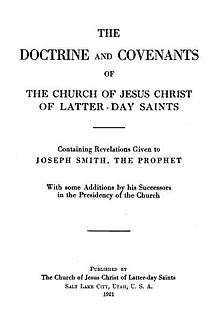Related Research Articles

The standard works of The Church of Jesus Christ of Latter-day Saints are the four books that currently constitute its open scriptural canon. The four books of the standard works are:

The Doctrine and Covenants is a part of the open scriptural canon of several denominations of the Latter Day Saint movement. Originally published in 1835 as Doctrine and Covenants of the Church of the Latter Day Saints: Carefully Selected from the Revelations of God, editions of the book continue to be printed mainly by The Church of Jesus Christ of Latter-day Saints and the Community of Christ.

Mormonism is the religious tradition and theology of the Latter Day Saint movement of Restorationist Christianity started by Joseph Smith in Western New York in the 1820s and 1830s. As a label, Mormonism has been applied to various aspects of the Latter Day Saint movement, although there has been a recent push from The Church of Jesus Christ of Latter-day Saints to distance themselves from this label. A historian, Sydney E. Ahlstrom, wrote in 1982, "One cannot even be sure, whether [Mormonism] is a sect, a mystery cult, a new religion, a church, a people, a nation, or an American subculture; indeed, at different times and places it is all of these". However, scholars and theologians within the Latter Day Saint movement, including Smith, have often used "Mormonism" to describe the unique teachings and doctrines of the movement.
In orthodox Mormonism, the term God generally refers to the biblical God the Father, whom Latter Day Saints refer to as Elohim, and the term Godhead refers to a council of three distinct divine persons consisting of God the Father, Jesus Christ, and the Holy Ghost. Latter Day Saints believe that the Father, Son, and Holy Ghost are three distinct beings, and that the Father and Jesus have perfected, glorified, physical bodies, while the Holy Ghost is a spirit without a physical body. Latter Day Saints also believe that there are other gods and goddesses outside the Godhead, such as a Heavenly Mother—who is the wife of God the Father—and that faithful Latter-day Saints may attain godhood in the afterlife. Joseph Smith taught that God was once a man on another planet before being exalted to Godhood.

The Encyclopedia of Mormonism is a semi-official English-language encyclopedia for topics relevant to The Church of Jesus Christ of Latter-day Saints. The five-volume texts have been digitized and are available for free online via the Harold B. Lee Library's official website.
The Journal of Discourses is a 26-volume collection of public sermons by early leaders of The Church of Jesus Christ of Latter-day Saints. The first editions of the Journal were published in England by George D. Watt, the stenographer of Brigham Young. Publication began in 1854, with the approval and endorsement of the church's First Presidency, and ended in 1886. The Journal is one of the richest sources of early Latter-day Saint theology and thinking. It includes 1,438 sermons given by 55 church leaders, including most numerously Brigham Young, John Taylor, Orson Pratt, Heber C. Kimball, and George Q. Cannon.

Carthage Jail is a historic building in Carthage, Illinois, listed on the National Register of Historic Places (NRHP). It was built in 1839 and is best known as the location of the 1844 killing of Prophet Joseph Smith, founder of the Latter Day Saint movement, and his brother Hyrum, by a mob of approximately 150 men. It was added to the NRHP in 1973 and is operated by The Church of Jesus Christ of Latter-day Saints as a historic site with an adjacent visitors' center.

The Pearl of Great Price is part of the canonical standard works of The Church of Jesus Christ of Latter-day Saints and some other Latter Day Saint denominations.

A meeting house is a building where religious and sometimes public meetings take place.
The fate of the unlearned, also known as the destiny of the unevangelized, is an eschatological question about the ultimate destiny of people who have not been exposed to a particular theology or doctrine and thus have no opportunity to embrace it. The question is whether those who never hear of requirements issued through divine revelations will be punished for failure to abide by those requirements.

The Improvement Era was an official magazine of The Church of Jesus Christ of Latter-day Saints between 1897 and 1970.

Moroni, according to the Book of Mormon, was the last Nephite prophet, historian, and military commander who lived in the Americas in the late fourth and early fifth centuries. He is later known as the Angel Moroni, who presented the golden plates to Joseph Smith, who translated the plates upon which the Book of Mormon was originally written.

Mormon cosmology is the description of the history, evolution, and destiny of the physical and metaphysical universe according to Mormonism, which includes the doctrines taught by leaders and theologians of The Church of Jesus Christ of Latter-day Saints, Mormon fundamentalism, the Restoration Church of Jesus Christ, and other Brighamite denominations within the Latter Day Saint movement. Mormon cosmology draws from Biblical cosmology, but has many unique elements provided by movement founder Joseph Smith. These views are not generally shared by adherents of other Latter Day Saint movement denominations who do not self-identify as "Mormons", such as the Community of Christ.
Terry Briggs Ball was the dean of Religious Education at Brigham Young University (BYU) from 2006 until 2013.

Wulf Erich Barsch von Benedikt is an American Latter-day Saint artist and professor at Brigham Young University (BYU).
Reed Connell Durham, Jr. is a historian of the Latter Day Saint movement and former director of the Institute of Religion in Salt Lake City, Utah for The Church of Jesus Christ of Latter-day Saints. Durham is remembered for a controversial speech given in 1974 about Freemasonry and the Latter Day Saint movement.
Pomeroy Tucker was a journalist and New York politician.
The Contributor was an independent publication associated with The Church of Jesus Christ of Latter-day Saints between 1879 and 1896. It was a monthly periodical and sought to represent the Young Men's and Young Ladies' Mutual Improvement Associations, the youth organizations of the LDS Church at the time. It was founded by Junius F. Wells, the inaugural head of the YMMIA.

Mormon art comprises all visual art created to depict the principles and teachings of The Church of Jesus Christ of Latter-day Saints, as well as art deriving from the inspiration of an artist's LDS religious views. Mormon art includes painting, sculpture, quilt work, photography, graphic art, and other mediums, and shares common attributes reflecting Latter-day Saint teachings and values.
References
- Barlow, Philip L. (1997), Mormons and the Bible: The Place of the Latter-day Saints in American Religion, New York: Oxford University Press, pp. 208–212, ISBN 0195062337, OCLC 21520650